AM uses splines (or B-splines) which should be familiar if you've used Illustrator or some other program that allows you to create line drawings with control points and tension modifiers. The only difference is now you get to worry about a third dimension, since the splines aren't limited to two.
Here are the rules for creating a "patch", or a rendered surface in AM.
1) It must consist of two or more intersecting splines.
2) It must consist of three, four or (special case) 5 control points.
A few illustrations will draw out the subtleties (get it? "Draw" out? Oh, never mind).
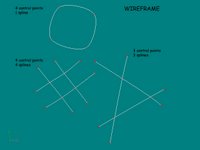
Here's an illustration of several ways you might arrange splines to make a figure. This is how you see splines in the modeler in wireframe mode. So far so good.
The first rule is the one that gets people in trouble right off the bat. The first instinct is to start dragging your mouse around and lay down a circle of four points. Sounds good, but then you render and nothing's there! The problem: an unbroken circle of points is a single spline. It won't render. You need to break the circle into 2 splines.
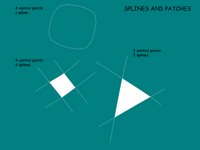
The second drawing points this out. This is how the patches will render. I've overlaid the wireframe for reference. The 3 and 4 point patches are evident. You can model everything with 3 point patches, but then that's just using a triangular polygonal modeler and you might as well buy a used copy of Lightwave 2.0. It's the 4 point patches that give you control over detailed curved surfaces. Three point patches lead down the road to unwanted creases, and are best left to hidden areas of the model.
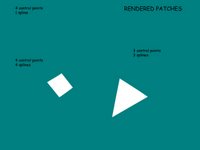 Here is the patches as they render. Notice that not only is the single spline patch not visible, neither are the parts of the splines that don't result in a 3 or 4 point patch. This can come in handy (although some count this as sloppy modeling, I still use the trick on occasion). We'll see this in the teapots.
Here is the patches as they render. Notice that not only is the single spline patch not visible, neither are the parts of the splines that don't result in a 3 or 4 point patch. This can come in handy (although some count this as sloppy modeling, I still use the trick on occasion). We'll see this in the teapots.This is a pretty simplistic overview, and leaves out a great deal of detail, but you should get the point.
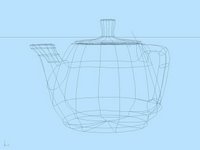 Here are a set of renders of a teapot (imagine that). The wire frame shows that this is a fairly low point set model, even though the curvature of the teapot is quite complex (and yes, I see some of the artifacts in the model. Its the age old trade off of detail vs. complexity.) This model serves quite well if it fill less than 25% of the screen (as most props do). Look closely and you'll see a couple of splines that dead end in space. I use them to tweak the curvature of the line without adding a lot of extra control points. Bad modeling, maybe, but it works.
Here are a set of renders of a teapot (imagine that). The wire frame shows that this is a fairly low point set model, even though the curvature of the teapot is quite complex (and yes, I see some of the artifacts in the model. Its the age old trade off of detail vs. complexity.) This model serves quite well if it fill less than 25% of the screen (as most props do). Look closely and you'll see a couple of splines that dead end in space. I use them to tweak the curvature of the line without adding a lot of extra control points. Bad modeling, maybe, but it works. The next two images are the final render. The first image is a standard shader with 3 point lighting. It renders pretty quick, and is the most useful render mode. (I also use cartoon shading a lot, but objects with complex features like the teapot don't stand out well.) The last image is the same setup, but with a single key light and the Ambient Occlusion feature turned on. This drives the render time up dramatically, but produces a very natural lighting scheme. A lot of renders using AO remind me of clay or plastic models on display.
The next two images are the final render. The first image is a standard shader with 3 point lighting. It renders pretty quick, and is the most useful render mode. (I also use cartoon shading a lot, but objects with complex features like the teapot don't stand out well.) The last image is the same setup, but with a single key light and the Ambient Occlusion feature turned on. This drives the render time up dramatically, but produces a very natural lighting scheme. A lot of renders using AO remind me of clay or plastic models on display.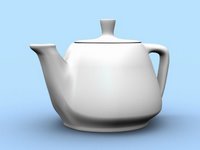
That does it for the basics of how AM models. I'll finish with a detailed image of the tori's roof, showing the log-like features I mentioned in an earlier post.
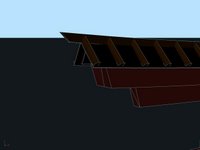
kgh

9 comments:
Thanks for posting the closeups and the renders.
How responsive is AM with a spline-heavy model? Is it the same with a regular program and a poly-heavy model?
AM is just like any other program--load it up with control points and splines and it bogs down.
It one reason I use time savers like bump maps, etc., to cut down on the spline count. It may not render any faster, but it makes modeling easier.
kgh
Very Interesting! Is modeling through splines the only modeling technique? i.e. Does it also support polygons?
Are there any other packages that model with B-Splines?
I don't know of any other package that uses B-splines exclusively.
AM can model with polygons if you make all your control points have zero magnitude, and use only 3 point patches. That would make it a triangular modeler like the old Lightwave.
AM also has plugins to export and import 3DS formats, as well as Avatar and Stanford polygon format.
MAX has patch modelling, and you can make your models with splines and then connect the dots, but I don't think it is as elegant/integrated as AM.
There is also a package called HamaPatch, or something like that, that uses at least patches, if not patches and splines.
http://www.geocities.com/hamapatch/program/
Hamapatch uses splines.
So is AM using NURBS or B-splines? How are they different?
Interesting question. Here's something of note that I dug up. A company called T-spline makes a plug-in for Maya which they say uses "cutting edge, patent-pending" technology. From the description, it is exactly the modeler that AM uses. Of course, the Maya plugin cost more than the entire AM package. Check it out at tspline.com.
I'm not a 3D math wizard, so I can't speak with certainty, but I've always felt that this method and Nurbs were kissin' cousins.
I went to the paper that introduced T-Splines at SIGGRAPH two years ago.
Here is a nice explanation of what a T spline is.
Basically, T-Splines allow you to put more detail where you need it without having to add extra control points to the areas that don't need it. For example, if you have a NURBS of a head and want to add detail to the nose, you can increase the control points on the nose without impacting the number of control points on the cheeks and mouth.
NURBS would require more control points for the entire head, not just for the nose.
Post a Comment